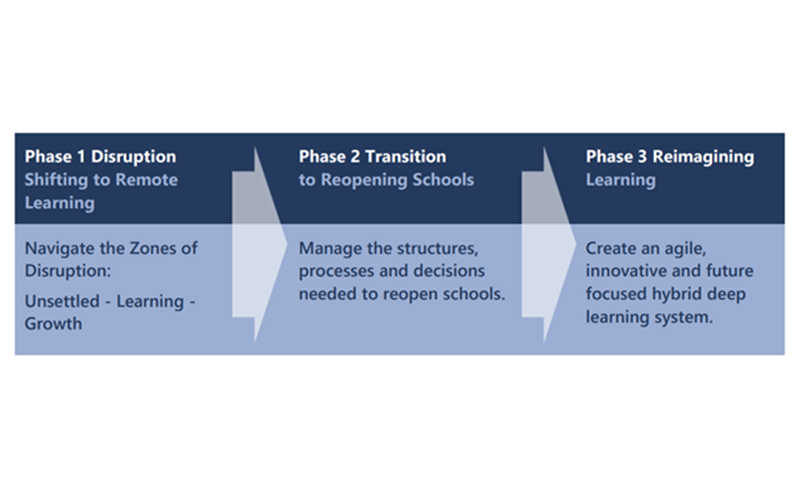Gaurav Aggarwal is a thought leader and strategist in Cloud and Digital Transformation with 26 plus years of experience. He is known for innovative and disruptive approach in driving Digital Transformation, developing scalable practices for Cloud, Application Modernization, Intelligent Experience, and IT outsourcing domains. Gaurav is currently the Global Lead for Everything on Azure Solution Strategy & GTM at Avanade, where he continues to help businesses that exploit technical breakthroughs. He is the principal strategist and visionary for business growth. In current role he drives a portfolio of $1 Billion+ pipeline for Cloud and Application Modernization business. Earlier as Modern Application and Application outsourcing business lead for Asia and LATAM he has delivered 30%+ YOY growth for Cloud & Application business ($250M+).
The Covid-19 pandemic has transformed school (K-12), higher education, and Professional Education. The change has been seen in their appearance, delivery medium, and internal operations. Lockdown of educational institutions has caused significant disruption to internal assessments, cancellation of public standardized tests, and the complete transfer from physical classes to digital learning spaces.
The education industry wasn’t prepared for a change of this magnitude. Many schools didn’t have proper software solutions to brave the upheaval. Even before the pandemic, according to the World Economic Forum, there was high growth and adoption of technology in education, with Global EdTech investments reaching $18.66 billion in 2019 and the overall market for online education projected to reach $350 billion by 2025.
As the pandemic intensified, higher education and the associated business network took a huge hit. The technological flux, the changing expectations of parents and students, the fear of an impending economic downturn, and the rising demand for online education were just some of the challenges facing educational institutions.
Subsequent waves pushed the timeline for return to classes into uncertainty. The outbreak has disrupted the plans for the class of 2020 to 2025 (academic years 2019 to 2025). Institutes are mulling over how to make the online model more result-oriented, ethical, and fair for students by deploying technology.
EdTech: Current state and why transformation is necessary
For decades, online education was perceived as only for the fringe: people who didn’t finish high school, stay-at-home parents looking to re-enter the workforce, workers looking to transition to a new industry. Today, some students are beginning to question the value of a college degree, and others can’t afford one. People are increasingly choosing to enter the workforce sooner or seeking alternative forms of education. The fallout from Covid-19, continuing advances in digital technology, and intensifying pent-up demand for student-centered learning have combined to present an unprecedented opportunity to transform education across whole systems.

Many institutions were already grappling with varying enrolment challenges. Only 4% of institutions were serving 55% of online students through scaled online programs before the pandemic. Increased competition, rising debt, and compliance costs have led to sustainability challenges. Stimulus funding isn’t enough to cover Covid costs. The other challenge is keeping students interested. Schools are struggling to find ways to engage and retain students digitally. Schools have to figure out tools that work and then implement them. And they have to do it now.
Schools need more than just technology to tide over the crisis. Successful remote work takes more than technology. It requires a culture that empowers people to do their jobs remotely and to build the skills they need in this new world of work. The migration to a flexible workforce needs an elastic strategy.
For the past decade, rising operating costs have fuelled conversations about rethinking higher ed business models. The pandemic has added urgency to the rethink. Institutions need business models that are scalable, cost-effective, and accessible enough to meet the needs of this decade and beyond.
An Accenture study says 65% of children starting school today will hold jobs that don’t exist yet. With a shift to rapid reskilling and lifelong learning, education must adapt to meet the learner’s needs. Predictive analytics offers opportunities to anticipate needs to present personalized recommendations and customized offerings.
Post the pandemic, EdTech companies must be mindful of the existing digital divide. Educational technology (MOOC platforms like eDX, Coursera, Emeritus) and online tutoring firms (Khan Academy, BYJU’s) offer free access to their services. The response has been overwhelming. Since announcing free live classes, BYJU’s has seen a 200% increase in the number of new students using its Think and Learn app.
Some believe that the sudden acceleration to online learning with no training and little preparation will result in a poor user experience and eventual return to in-person classes. Others think online education will eventually become an integral component of secondary and higher education through increased integration of IT, and a new hybrid model of education will emerge.
Institutions are looking at hybrid models for students. They must learn lessons from models that had been in existence even before the pandemic. Though online/hybrid models have existed, they have never been truly integrated. Institutions have a few graduate programs, some certificate programs, and occasionally an executive education program. Each of these programs was ringfenced and therefore never really improved education delivery by optimizing the gains of each other. As institutions prepare for more virtual semesters, EdTech will help strengthen academic delivery.
Challenges with online and hybrid education
A survey by EdTech Evidence Exchange and the University of Virginia found that 86% of teachers believe the necessity for new technologies in schools will increase over the next three years to offset the pandemic’s impact, improve learning outcomes, and reduce socioeconomic and racial disparities.
According to OECD data, while 95% of students in Switzerland, Norway, and Austria have a computer to use for their schoolwork, only 34% in Indonesia have access. This digital divide is seen across countries and between income brackets within countries.
But developing and implementing an effective IT compliance program and providing ongoing maintenance can be tricky. When building EdTech products, business owners must consider privacy. When your technology is designed for kids, it is essential to ensure consumer trust and mitigate risk by following privacy laws and best practices. Failure to comply can have legal implications.
Leaders remain steadfast in their commitment to their core missions even in the face of these severe challenges. However, now is the time for higher education institutions to reconsider their value propositions and to operate models to successfully and sustainably deliver their mission in the years to come.
The other problem staring online education backers is the threat posed by Cyberattacks and hackers. The overall number of Distributed Denial of Service attacks during the first three months of 2020 saw a significant spike in attacks on educational websites as millions joined online classes during the pandemic.
These are areas where participation of government, non-governmental organizations, and the private sector, led by EdTech firms, assumes greater importance. These arms can come together to ensure an enabling environment for online education with deeper penetration and ease of availability for all eligible.

Need for co-innovation
Education leaders are increasingly on the lookout for how technology can optimize and modernize. Technology providers and EdTech need to seize this opportunity to provide a more integrated approach to hybrid education encompassing the use of immersive experiences (AR / VR / Extended Reality, Mixed Reality), AI and ML, Robotics, Public Cloud, Video Analytics, etc. Technology also needs to be developed to conduct exams fairly and ethically for the evaluation of learning objectives. Current approaches of lockdown browser/app, kiosk mode for desktop, proctored exams (with someone monitoring the student for patterns) are not scalable and economical options.
According to an Accenture study, nearly 50% of college and university presidents anticipate making challenging but transformational changes in their institutions in the next 12 months. According to the same survey, faculty members are now more open to alternatives approaches and leveraging technology.
Two trends bear watching. First, the biggest technology companies have been able to throw resources at schools and make significant inroads. Google and Microsoft have won millions of new users by giving their tools away, working directly with governments, and repurposing existing products as needed (though they are not as easy to use as they should be).
The transformation required here is more than people, processes, or technology. I see this journey to be a three steps process.
The education sector needs to look beyond innovation and adopt transformation frameworks like Microsoft Education Transformation Framework provides practical advice to help develop a strategy for digital transformation with a holistic, long-term view implemented in discrete phases.
Tech and teaching: Putting it all together
Technology is disrupting education as it is in every other industry. But education is a little different than other industries because it uniquely creates our future capabilities. It’s, therefore, more important than ever that educational institutes and governments plan for the future of work and life.
Lifelong learning is now essential. Lifelong learning is also implicit in our humanity—we are by nature explorers and creators—and the opportunity to learn should inspire our lives. The future of work will see people having multiple careers over a much longer working life than they do today. As technology disrupts our society, we need to adapt to working with technology and shift to new careers as technology and automation augment traditionally human tasks.
The Covid-19 pandemic and its unprecedented social and economic disruptions have intensified pressures on the education sector (K-12 and Higher Education), demanding an immediate response. Institutions have been consumed with operational triage and prioritizing safety, communication, and education continuity. Despite the ongoing challenges the pandemic presents, institutions would benefit from leaders carving out time to look beyond immediate demands and consider their institution’s longer-term prospects.
The hybrid Education model must embrace digital to amplify, accelerate and connect learners and learning while intentionally focusing on global competencies and academic standards. It’s easy to be enthusiastic about bringing incredible new technology into the classroom, yet there are some critics. However, what’s most encouraging is how the Academic institute, EdTech, and technology are finally coming together in ways that promote a flexible, interdisciplinary approach that helps all learners succeed at home and in the classroom. This is ultimately the decade where we’ll see it all come together.




